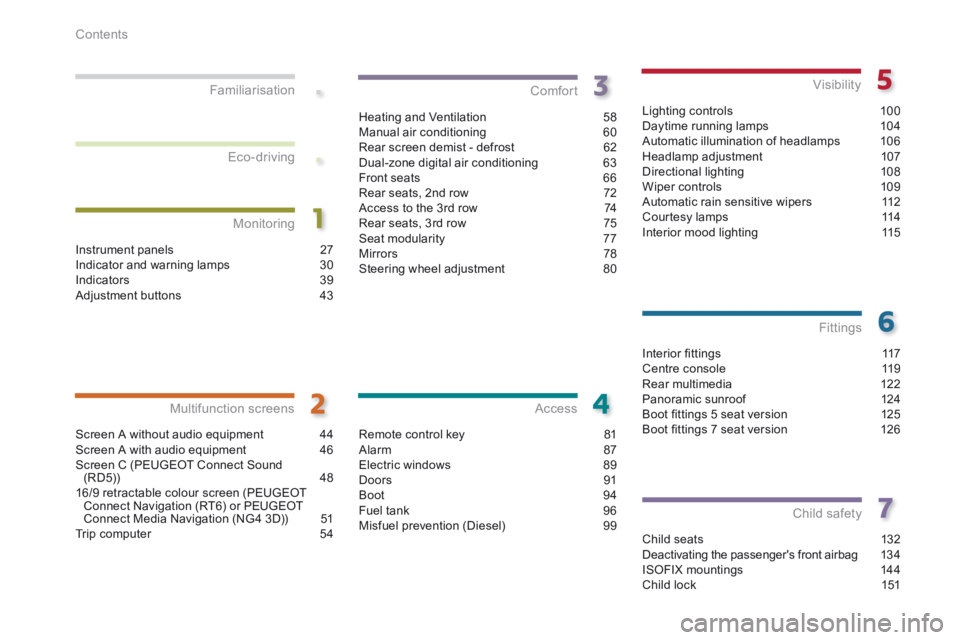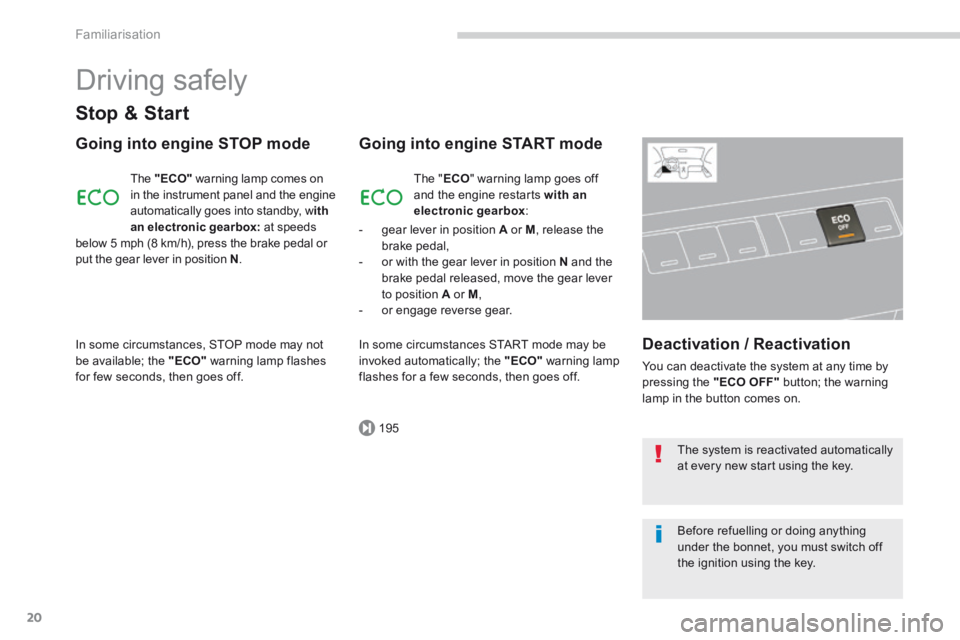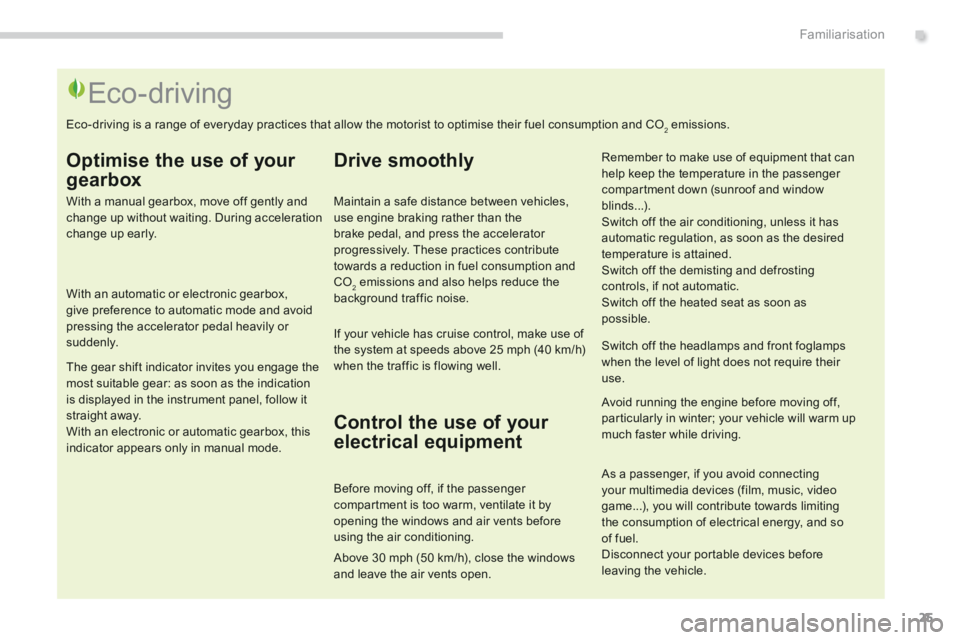Page 4 of 404

.
.
Contents
Interior fi ttings 117Centre console 119Rear multimedia 122Panoramic sunroof 124Boot fi ttings 5 seat version 125Boot fi ttings 7 seat version 126
Fittings
Child seats 132Deactivating the passenger's front airbag 13 4ISOFIX mountings 144Child lock 151
Child safety
Instrument panels 27Indicator and warning lamps 30Indicators 39Adjustment buttons 43
Monitoring
Familiarisation
Screen A without audio equipment 44Screen A with audio equipment
46Screen C (PEUGEOT Connect Sound (RD5)) 4816/9 retractable colour screen (PEUGEOT Connect Navigation (RT6) or PEUGEOT Connect Media Navigation (NG4 3D)) 51Trip computer 54
Multifunction screens
Heating and Ventilation 58Manual air conditioning 60Rear screen demist - defrost 62Dual-zone digital air conditioning 63Front seats 66Rear seats, 2nd row 72Access to the 3rd row 74Rear seats, 3rd row 75Seat modularity 77Mirrors 78Steering wheel adjustment 80
Comfort
Remote control key 81Alarm 87Electric windows 89Doors 91Boot 94Fuel tank 96Misfuel prevention (Diesel) 99
Access
Lighting controls 100Daytime running lamps 104Automatic illumination of headlamps 106Headlamp adjustment 107Directional lighting 108Wiper controls 109Automatic rain sensitive wipers 112Courtesy lamps 114Interior mood lighting 115
Visibility
Eco-driving
Page 11 of 404
.Familiarisation9
Instruments and controls
1. Cruise control / speed limiter switches.
2. Steering wheel adjustment.
3. Lighting and direction indicator stalk.
4. Instrument panel.
5. Driver's airbag.
Horn.
6. Gear lever.
7. Electric parking brake.
8. 12 V accessories socket.
9. Panoramic sunroof control.
10. Owner's Handbook storage compartment.
11. Bonnet release.
12 . Door mirror controls.
Electric window controls.
Child lock.
13. Manual headlamp height adjustment.
14 . Side switch panel.
15. Front door window demist/defrost vent.
16. Windscreen demist/defrost vent.
Page 18 of 404
27
30
198
156
87
201
195
173
152
175
92
Familiarisation
16
Monitoring
Instrument panels
A. With the ignition on, the needle should indicate the level of fuel remaining.
B. With the engine running, its associated low level warning lamp should go off. C. With the ignition on, the oil level indicator should display "OIL OK" for a few seconds (depending on version). If the levels are not correct, top up the levels which are low.
Warning lamps
1. With the ignition on, the orange and red warning lamps come on.
2. With the engine running, these warning lamps should go off. If warning lamps remain on, refer to the section in question.
Switch panels
Lighting of the indicator lamp indicates the status of the corresponding function. A. Visual and audible parking sensors.
B. ASR /DSC OFF
C. Volumetric alarm.
D. Parking space sensors.
E. Stop & Start.
F. Head-up display.
G. Hazard warning lamps.
Side
Central
H. Distance alert.
I. Central locking.
Page 22 of 404

195
Familiarisation
20
Driving safely
Stop & Start
Going into engine STOP mode
The "ECO" warning lamp comes on in the instrument panel and the engine automatically goes into standby, w ith
an electronic gearbox: at speeds below 5 mph (8 km/h), press the brake pedal or put the gear lever in position N .
In some circumstances, STOP mode may not be available; the "ECO" warning lamp flashes for few seconds, then goes off.
Going into engine START mode
The "ECO" warning lamp goes off and the engine restarts with an electronic gearbox :
In some circumstances START mode may be invoked automatically; the "ECO" warning lamp flashes for a few seconds, then goes off.
Deactivation / Reactivation
You can deactivate the system at any time by pressing the "ECO OFF" button; the warning lamp in the button comes on.
The system is reactivated automatically at every new start using the key.
Before refuelling or doing anything under the bonnet, you must switch off the ignition using the key.
- gear lever in position A or M , release the brake pedal, - or with the gear lever in position N and the brake pedal released, move the gear lever to position A or M , - or engage reverse gear.
Page 23 of 404

.
166
Familiarisation21
Driving safely
Electric parking brake
Manual application / release
The parking brake can be applied manually by pulling the control lever A . When the ignition is on, the parking brake can be released manually by pressing the brake pedal and pulling then releasing the control lever A .
Automatic application / release
Press the accelerator, press and and release the clutch (manual gearbox), the parking brake is released automatically and progressively on acceleration. With the vehicle stationary, when the engine is switched off , the parking brake is is switched off , the parking brake is is switched offappliedautomatically.
Before getting out of the vehicle, check that the braking warning lamp ( red ! ) and the warning lamp P , P , Plocated in the control lever Aare on fixed (not flashing).
If this warning lamp is on in the instrument panel, the automatic application/release is deactivated , in this case use the manual application/release.
If you are towing a trailer or a caravan
or if the gradient is likely to change (transport by ship, lorry, towing, ...), apply the parking brake manually to maximum force (long pull on control lever A ) to immobilise the vehicle. A ) to immobilise the vehicle. A When the door is opened with the engine running an audible signal is heard, apply the parking brake manually. Do not leave a child alone in the vehicle with the ignition on, they could release the parking brake.
Page 25 of 404
.
178181
Familiarisation23
Driving safely
Speed limiter "LIMIT"
1. Limiter mode Selection / Off. 2. Decrease the programmed value. 3. Increase the programmed value. 4. Speed limiter On / Off.
Cruise control "CRUISE"
1. Cruise control mode Selection / Off. 2. Programme a speed / Decrease the programmed value. 3. Programme a speed / Increase the programmed value. 4. Cruise control Off / Resume.
Display in the instrument panel
The cruise control or speed limiter mode appears in the instrument panel when it is selected.
Cruise control
Speed limiter
The values must be set with the engine running. In order to be programmed or activated, the vehicle speed must be higher than 25 mph (40 km/h), with at least fourth gear engaged on the manual gearbox (second gear for an electronic or automatic gearbox).
Page 27 of 404

.Familiarisation25
Eco-driving
Optimise the use of your
gearbox
With a manual gearbox, move off gently and change up without waiting. During acceleration change up early.
With an automatic or electronic gearbox, give preference to automatic mode and avoid pressing the accelerator pedal heavily or suddenly.
The gear shift indicator invites you engage the most suitable gear: as soon as the indication is displayed in the instrument panel, follow it straight away. With an electronic or automatic gearbox, this indicator appears only in manual mode.
Drive smoothly
Maintain a safe distance between vehicles, use engine braking rather than the brake pedal, and press the accelerator progressively. These practices contribute towards a reduction in fuel consumption and CO2 emissions and also helps reduce the background traffic noise.
If your vehicle has cruise control, make use of the system at speeds above 25 mph (40 km/h) when the traffic is flowing well.
Remember to make use of equipment that can help keep the temperature in the passenger compartment down (sunroof and window blinds...). Switch off the air conditioning, unless it has
automatic regulation, as soon as the desired temperature is attained. Switch off the demisting and defrosting controls, if not automatic. Switch off the heated seat as soon as possible.
Switch off the headlamps and front foglamps when the level of light does not require their use.
Avoid running the engine before moving off, particularly in winter; your vehicle will warm up much faster while driving.
Eco-driving is a range of everyday practices that allow the motorist to optimise their fuel consumption and CO2 emissions.
As a passenger, if you avoid connecting your multimedia devices (film, music, video game...), you will contribute towards limiting the consumption of electrical energy, and so of fuel. Disconnect your portable devices before leaving the vehicle.
Control the use of your
electrical equipment
Before moving off, if the passenger compartment is too warm, ventilate it by opening the windows and air vents before using the air conditioning.
Above 30 mph (50 km/h), close the windows and leave the air vents open.
Page 29 of 404
1
Monitoring27
Instrument panels
Panel grouping together the vehicle operation indication dials and warning lamps. Dials
1. Rev counter. Indicates the engine speed (x 1 000 rpm). 2. Coolant temperature. Indicates the temperature of the engine coolant (°Celsius). 3. Fuel level. Indicates the quantity of fuel remaining in the tank. 4. Speedometer. Indicates the current speed of the moving vehicle (mph or km/h). 5. Screen.6. Display zero reset or ser vice indicator re-display button. Resets the selected function to zero (trip distance recorder or service indicator) or displays the service indicator again. 7. Instrument panel lighting dimmer. Adjusts the brightness of the lighting of
the instruments and controls, if the vehicle lighting is on.
For more information, refer to the section corresponding to the button or function and its associated display.